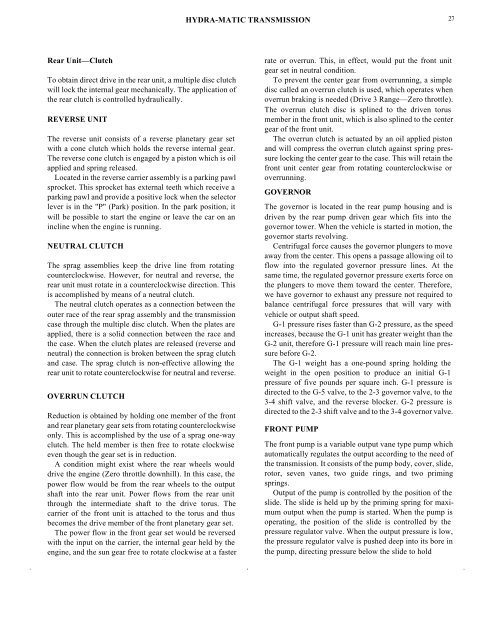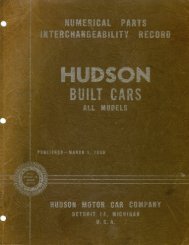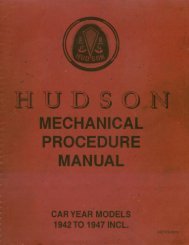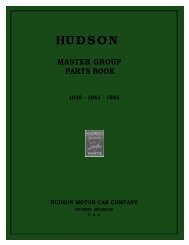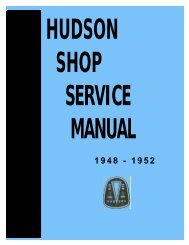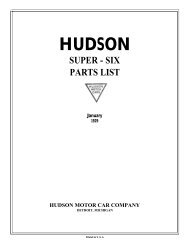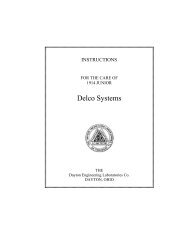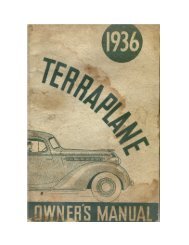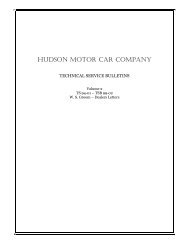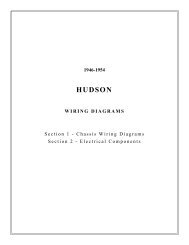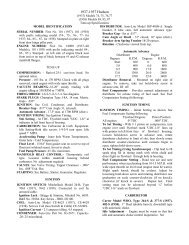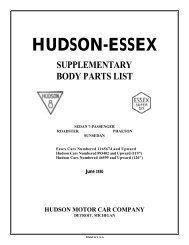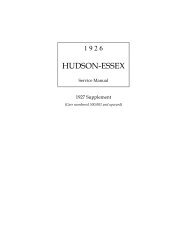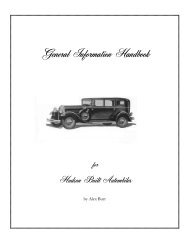1956 AMC Hudson Technical Service Manual Supplement
1956 AMC Hudson Technical Service Manual Supplement
1956 AMC Hudson Technical Service Manual Supplement
You also want an ePaper? Increase the reach of your titles
YUMPU automatically turns print PDFs into web optimized ePapers that Google loves.
HYDRA-MATIC TRANSMISSION 27<br />
Rear Unit—Clutch<br />
To obtain direct drive in the rear unit, a multiple disc clutch<br />
will lock the internal gear mechanically. The application of<br />
the rear clutch is controlled hydraulically.<br />
REVERSE UNIT<br />
The reverse unit consists of a reverse planetary gear set<br />
with a cone clutch which holds the reverse internal gear.<br />
The reverse cone clutch is engaged by a piston which is oil<br />
applied and spring released.<br />
Located in the reverse carrier assembly is a parking pawl<br />
sprocket. This sprocket has external teeth which receive a<br />
parking pawl and provide a positive lock when the selector<br />
lever is in the "P" (Park) position. In the park position, it<br />
will be possible to start the engine or leave the car on an<br />
incline when the engine is running.<br />
NEUTRAL CLUTCH<br />
The sprag assemblies keep the drive line from rotating<br />
counterclockwise. However, for neutral and reverse, the<br />
rear unit must rotate in a counterclockwise direction. This<br />
is accomplished by means of a neutral clutch.<br />
The neutral clutch operates as a connection between the<br />
outer race of the rear sprag assembly and the transmission<br />
case through the multiple disc clutch. When the plates are<br />
applied, there is a solid connection between the race and<br />
the case. When the clutch plates are released (reverse and<br />
neutral) the connection is broken between the sprag clutch<br />
and case. The sprag clutch is non-effective allowing the<br />
rear unit to rotate counterclockwise for neutral and reverse.<br />
OVERRUN CLUTCH<br />
Reduction is obtained by holding one member of the front<br />
and rear planetary gear sets from rotating counterclockwise<br />
only. This is accomplished by the use of a sprag one-way<br />
clutch. The held member is then free to rotate clockwise<br />
even though the gear set is in reduction.<br />
A condition might exist where the rear wheels would<br />
drive the engine (Zero throttle downhill). In this case, the<br />
power flow would be from the rear wheels to the output<br />
shaft into the rear unit. Power flows from the rear unit<br />
through the intermediate shaft to the drive torus. The<br />
carrier of the front unit is attached to the torus and thus<br />
becomes the drive member of the front planetary gear set.<br />
The power flow in the front gear set would be reversed<br />
with the input on the carrier, the internal gear held by the<br />
engine, and the sun gear free to rotate clockwise at a faster<br />
rate or overrun. This, in effect, would put the front unit<br />
gear set in neutral condition.<br />
To prevent the center gear from overrunning, a simple<br />
disc called an overrun clutch is used, which operates when<br />
overrun braking is needed (Drive 3 Range—Zero throttle).<br />
The overrun clutch disc is splined to the driven torus<br />
member in the front unit, which is also splined to the center<br />
gear of the front unit.<br />
The overrun clutch is actuated by an oil applied piston<br />
and will compress the overrun clutch against spring pressure<br />
locking the center gear to the case. This will retain the<br />
front unit center gear from rotating counterclockwise or<br />
overrunning.<br />
GOVERNOR<br />
The governor is located in the rear pump housing and is<br />
driven by the rear pump driven gear which fits into the<br />
governor tower. When the vehicle is started in motion, the<br />
governor starts revolving.<br />
Centrifugal force causes the governor plungers to move<br />
away from the center. This opens a passage allowing oil to<br />
flow into the regulated governor pressure lines. At the<br />
same time, the regulated governor pressure exerts force on<br />
the plungers to move them toward the center. Therefore,<br />
we have governor to exhaust any pressure not required to<br />
balance centrifugal force pressures that will vary with<br />
vehicle or output shaft speed.<br />
G-1 pressure rises faster than G-2 pressure, as the speed<br />
increases, because the G-1 unit has greater weight than the<br />
G-2 unit, therefore G-1 pressure will reach main line pressure<br />
before G-2.<br />
The G-1 weight has a one-pound spring holding the<br />
weight in the open position to produce an initial G-1<br />
pressure of five pounds per square inch. G-1 pressure is<br />
directed to the G-5 valve, to the 2-3 governor valve, to the<br />
3-4 shift valve, and the reverse blocker. G-2 pressure is<br />
directed to the 2-3 shift valve and to the 3-4 governor valve.<br />
FRONT PUMP<br />
The front pump is a variable output vane type pump which<br />
automatically regulates the output according to the need of<br />
the transmission. It consists of the pump body, cover, slide,<br />
rotor, seven vanes, two guide rings, and two priming<br />
springs.<br />
Output of the pump is controlled by the position of the<br />
slide. The slide is held up by the priming spring for maximum<br />
output when the pump is started. When the pump is<br />
operating, the position of the slide is controlled by the<br />
pressure regulator valve. When the output pressure is low,<br />
the pressure regulator valve is pushed deep into its bore in<br />
the pump, directing pressure below the slide to hold


